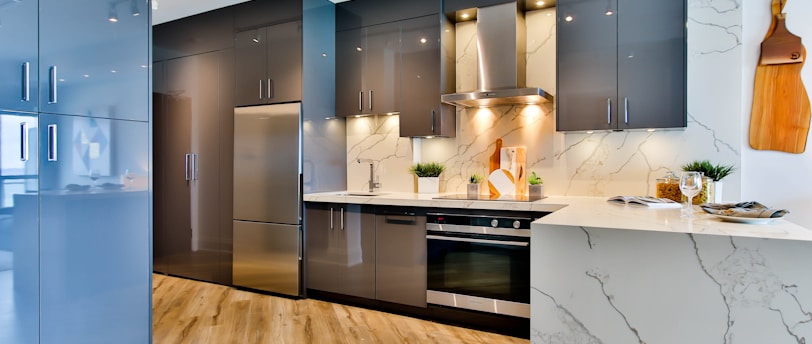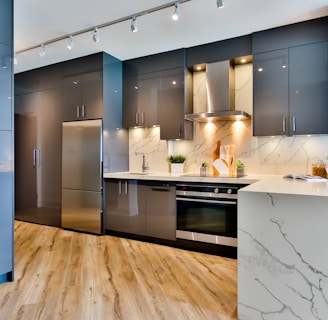Sustainable Spaces: The Kitchen
From induction ranges to faucet aerators, there are many ways to boost a kitchen’s sustainability score.
SUSTAINABLE SPACESHOME DESIGN


Sustainable Spaces: The Kitchen
REALTOR® Magazine | article by Leandra Beabout | April 9, 2024
From induction ranges to faucet aerators, there are many ways to boost a kitchen’s sustainability score.
You've heard it here before: More than half of real estate professionals recently reported that their clients are interested in sustainability. For some homeowners, environmental consciousness is a lifestyle choice. For others, going green is purely practical. Reducing energy and water use lowers utility bills, after all. Sustainable home features can also become selling points in property listings.
Of course, every room in a structure comes with its own environmental challenges. Whether you're interested in an eco-friendly new build or are considering a renovation, the kitchen is a great place to focus efforts.
The Importance of Sustainable Kitchen Design
"The first priority of a renovation or new build should be the sustainability and long-term use of the kitchen," says Nicci Pucci, real estate professional and owner and principal designer of Tambourine Home in Las Vegas.
Jeff Manning, CEO of ABG Builders, a West Coast commercial construction and development company, agrees: "Kitchen and bathroom upgrades add more marketability, resale value, and open the home for greater appreciation."
Homes with environmentally friendly kitchens pack in several selling points:
Sustainable kitchens reduce energy and water bills.
Sustainable kitchens lead to positive buyer perception.
Sustainable kitchens are often healthier due to the incorporation of natural materials that are inherently antimicrobial.
Building a Sustainable Kitchen from the Ground Up
What makes a kitchen sustainable? Manning says it is a combination of several factors, from energy and efficiency to plenty of natural light and air circulation. Creating a sustainable kitchen in a new build is easiest, but there are still ways to boost eco-friendliness in existing homes.
Following these sustainable kitchen design ideas can help a new build stand out. They're also helpful considerations for homeowners who want to renovate the kitchen to boost home value.
Consult the experts
Sustainability is trending, which means there are always new energy-efficient and eco-friendly products and materials on the market. To stay on the leading edge, builders and developers remain in contact with experts in the field.
"Consulting with the United States Green Building Council for Residential Kitchens is the first item a savvy home owner or developer might do," says Manning. "This internationally recognized organization has guidelines and parameters for outlining the best methods for an energy efficient kitchen."
Assess the 'building envelope'
"In new construction, the first places to save energy would be through the building envelope — things like insulation and types of windows, then looking at the heating and cooling systems…" says Jennifer Turchin, a LEED--accredited architect at Coda Group, a sustainability consulting firm in Southern Nevada.
Of course, this assessment applies to the entire building, not just the kitchen. But kitchen cooling and insulation are critical since the space tends to be heated and used frequently.
Install an under-sink heater
In the kitchen, hot water is necessary for cooking, washing up, and making hot drinks. Have you ever noticed how much time and water are wasted running the tap while you wait for it to get hot? There's a solution for that.
"Adding insta-hots" — under-counter instant water heating tanks — "directly under the water fixture in the kitchen can speed up the time it takes to heat water and reduce the wasted amount of water significantly," explains Manning.
Choose energy-efficient appliances
More than 60% of agents and brokers say promoting energy efficiency in listings is valuable, according to National Association of REALTORS® (NAR) data. But real estate professionals should also stay educated on which Energy Star kitchen appliances are turning buyers' heads.
"Something to point out to buyers is the brand of appliances, and what those brands are doing on a broader scale when it comes to eco-friendly manufacturing and packaging," says Pucci.
"Brands like Asko, Miele, Speed Queen, Sub Zero and Wolf test their products for at least 20 years of regular use."
Top-of-the-line appliances aren't cheap — Pucci says a 72" refrigerator and freezer cost about $18,000 — but sustainability-savvy buyers appreciate the brands' reputations and how these units are built to last. Turchin points out that modern refrigerators can save energy in small ways, such as how some units show you what is inside without opening the door.
Skip the gas stove
Energy Star data shows that induction cooktops are up to 10% more efficient than electric and 300% more efficient than gas.
If an induction range is out of the question, opt for electric over gas. "There are some studies that show electric appliances are both more efficient and produce less toxins in our indoor environment," Turchin explains.
Be strategic about natural light
Natural light reduces reliance on electricity, but that doesn't mean floor-to-ceiling windows are best. Windows should be well-insulated (triple-pane, if possible) to stabilize indoor temperatures. Because heat rises, skylights and operable clerestories — rows of windows above eye level — allow light to pour in without heating the kitchen.
Of course, natural light isn’t available all the time. Manning says LEDs are the best artificial lights for sustainable kitchen designs.
Install proper venting
Proper air exchange is crucial for sustainable kitchen design, according to Manning. Adequate venting helps maintain a comfortable temperature while eliminating smells and toxins from cooking.
“Recirculating charcoal filters are great and the best option if a route to an outdoor vent is not possible,” adds Pucci.
Incorporate sustainable, healthy materials
Kitchens have a lot of surface types: floors, countertops, cabinetry, and more. Opt for sustainable materials such as natural stone, reclaimed wood, cork, or concrete whenever possible. According to Manning, eco-friendly countertops, wallpapers, and even insulation products are all available.
"There are countertops that have antimicrobial properties built in, so they don't need to be cleaned with as many harsh chemicals," says Turchin.
As for cabinets, Pucci recommends Greenguard Gold–certified cabinetry because it is guaranteed to have low levels of formaldehyde.
Boosting Sustainability in Existing Kitchens
If homeowners want to leverage the benefits of sustainable design in an existing kitchen, the experts have a few tips:
When possible, work with an interior designer. "A $30,000 renovation can easily double in value come appraisal time, and an interior designer is your best resource in finding environmentally friendly options for a simple kitchen update, renovation or new build,” says Pucci.
Swap out old lightbulbs. One of the easiest updates also offers immediate benefits. "All lighting should be replaced with LED bulbs which last longer and immediately reduce energy consumption," says Turchin.
Replace outdated appliances. This lowers energy costs and increases value to potential buyers. "The EPA estimates that a typical household using Energy Star appliances can expect to save $450 on their energy bills each year," says Turchin.
Aerate the faucet. "A high-efficiency aerator will save overall water use and provide energy savings," says Turchin. Faucet flow restrictors can reduce water consumption from 2.5 gallons per minute to 1.2 gallons, all without a loss of pressure, according to kitchen fittings company GROHE.
